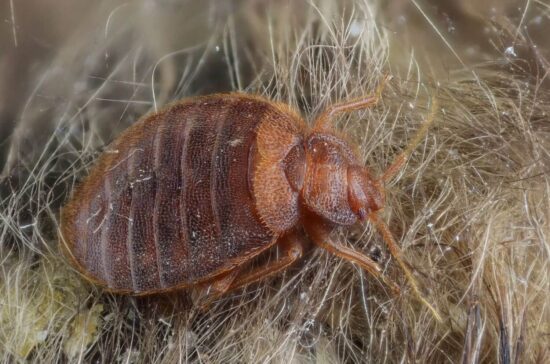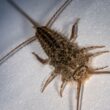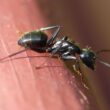Bed bugs are making a comeback, and nobody wants these uninvited guests in their home. The tricky part is figuring out if you actually have them. Many people think bed bug bites are the best way to tell, but that’s not always reliable. About 30% of people don’t react to bed bug bites at all, so they might never see any marks on their skin.
The good news is that bed bugs leave behind plenty of other clues. Learning how to tell if you have bed bugs means looking for physical evidence around your sleeping area. These tiny pests can’t hide all their tracks, and knowing what to look for can help you catch an infestation early before it gets out of control.
1. Look for Bite Marks in a Line or Zigzag Pattern
One of the most common ways people first suspect bed bugs is through their bites. When bed bugs feed, they often create a distinctive pattern that pest experts call “breakfast, lunch, and dinner.” These bites typically show up in groups of three to five, arranged in a straight line or zigzag pattern.
- Kill bed bugs and bed bug eggs
- Use spray as a spot treatment around bed frames, mattress seams/tufts/folds, and baseboards
- Kills even the toughest bed bugs
- The continuous spray Comfort Wand easily gets into hard-to-reach areas
Bed bug bites usually appear on skin that’s exposed while you sleep. This includes your arms, neck, shoulders, and legs. The bites themselves look like small, red, raised bumps with a darker center. They’re often very itchy and can take anywhere from a few hours to two weeks to show up after you’ve been bitten.
But here’s the catch: bed bug bites can look exactly like mosquito bites, flea bites, or even skin rashes. Plus, some people never develop any reaction to the bites at all. That’s why bite marks alone aren’t enough to confirm you have bed bugs.
If you wake up with mysterious bite marks in a line pattern, it’s definitely worth investigating further. But remember that figuring out how to tell if you have bed bugs requires looking for other evidence too.
2. Check Your Bedding for Blood Stains
When you roll over in your sleep, you might accidentally crush a bed bug that just finished feeding. This creates reddish or rust-colored stains on your sheets, pillowcases, or mattress. These blood stains are one of the most reliable signs of a bed bug problem.
Look for small, rust-colored smears or spots on your bedding, especially in areas where your body makes the most contact. The stains are usually pretty small, but they stand out because of their distinctive rusty color. Fresh stains might look more red, while older ones turn brown or rust-colored.
These blood stains happen because bed bugs fill up with your blood when they feed. If you move around while they’re still digested, the blood gets squeezed out and stains the fabric. It’s gross to think about, but it’s actually helpful evidence when you’re trying to figure out if you have these pests.
Check your sheets every time you change your bedding. Blood stains from bed bugs are different from other types of stains because they show up in spots where you sleep, not where you might have had a nosebleed or cut.
3. Find Small Dark Spots That Look Like Ink Stains
Bed bugs leave behind fecal matter that looks like tiny dark spots on your bedding and furniture. These spots are about the size of a period at the end of a sentence, and they’re one of the best ways to confirm you have bed bugs.
The spots are dark brown to black and look like someone dabbed a felt-tip marker on the fabric. When the droppings are fresh, they might smear if you touch them, just like ink would. On hard surfaces, they might look like tiny dark beads.
You can test whether dark spots are bed bug droppings by dabbing them with a damp cloth or alcohol wipe. If the spots turn reddish brown when you wipe them, that’s a strong sign they’re bed bug feces. Regular dirt or other stains won’t change color this way.
Look for these spots along mattress seams, on box springs, and in cracks around your bed frame. You might also find them on nearby furniture, baseboards, or wall cracks. The spots often show up in clusters near where the bugs like to hide during the day.
This is one of the most reliable methods for how to tell if you have bed bugs because the feces can only come from the bugs themselves.
4. Search for Tiny Pale Eggs and Empty Eggshells
Female bed bugs lay small, white eggs about the size of a pinhead. These eggs are oval-shaped and have a slightly yellowish or pearl-white color. Finding these eggs is a clear sign that bed bugs are not just visiting your home but actually living and breeding there.
Bed bug eggs are tiny, measuring only about 1 millimeter long. That’s roughly the size of two human hairs placed side by side. Because they’re so small, you might need a magnifying glass to see them clearly. The eggs are often glued to surfaces in cracks and crevices where the bugs hide.
Female bed bugs can lay one to three eggs per day and up to 500 eggs during their lifetime. They prefer to lay eggs in dark, protected areas like mattress seams, bed frame joints, and furniture cracks. You might find the eggs in small clusters or scattered individually.
Empty eggshells are just as important to find as whole eggs. These shells look like tiny, clear or yellowish hollow cases. Finding empty shells means baby bed bugs have already hatched and are growing somewhere in your home.
Look for eggs and eggshells in the same places you’d search for live bugs: mattress seams, box spring corners, bed frame cracks, and nearby furniture.
5. Notice Shed Skins and Molted Shells
As bed bugs grow from babies to adults, they shed their skin five different times. These shed skins, called molts, are another clear sign of a bed bug problem. The skins look like empty, translucent shells that are roughly the same shape as a bed bug but hollow inside.
The molted skins are usually light brown or yellowish and see-through. They’re different sizes depending on which growth stage the bug was in when it shed. The smallest ones are barely visible, while the largest ones are about the size of an adult bed bug.
Finding multiple shed skins means you have bed bugs that are actively growing and developing in your home. Since bed bugs must molt to reach each new life stage, discovering these shells tells you the population is thriving and likely getting bigger.
You’ll typically find shed skins in the same areas where bed bugs like to hide: mattress seams, bed frame cracks, upholstered furniture seams, and baseboards. The more skins you find, the more established the infestation probably is.
Look for these papery, hollow shells when you’re doing a thorough inspection of your sleeping area. They’re easier to spot than live bugs and stick around longer than other types of evidence.
- Kill bed bugs and bed bug eggs
- Use spray as a spot treatment around bed frames, mattress seams/tufts/folds, and baseboards
- Kills even the toughest bed bugs
- The continuous spray Comfort Wand easily gets into hard-to-reach areas
6. Smell for a Sweet, Musty Odor
Bed bugs produce a distinctive smell that many people compare to sweet berries, almonds, or fresh coriander. This odor comes from chemicals called pheromones that the bugs use to communicate with each other. While not everyone can detect this smell, it’s another helpful clue when figuring out how to tell if you have bed bugs.
The smell becomes more noticeable as the bed bug population grows. In small infestations, you might not smell anything at all. But with larger populations, the sweet, musty odor can become quite strong, especially in enclosed spaces like bedrooms.
When bed bugs feel threatened or get disturbed, they release alarm pheromones that can smell even stronger. Some people describe this as similar to the smell that stink bugs make when you squish them. In severe infestations, this smell can mix with the odor of dead bugs and waste, creating a rusty or metallic scent.
The smell is usually strongest in areas where bed bugs gather in large numbers, like behind headboards or inside mattress seams. If you notice an unexplained sweet, musty smell in your bedroom that doesn’t go away, it’s worth investigating further.
Not everyone’s nose is sensitive enough to detect bed bug odors, so don’t rely on smell alone. But if you do notice this distinctive scent along with other signs, it can help confirm your suspicions.
7. Look for Live Bed Bugs
Actually seeing a live bed bug is the most definitive way to confirm you have them. Adult bed bugs are about the size and shape of an apple seed, with flat, oval bodies that are reddish-brown in color. When they haven’t eaten recently, they’re quite flat. After feeding, they become more rounded and darker.
Baby bed bugs, called nymphs, are much smaller and harder to see. They’re translucent or whitish-yellow and can be nearly invisible if they haven’t fed recently. The smallest nymphs are only about 1 millimeter long.
Bed bugs are most active at night when they come out to feed. During the day, they hide in dark, tight spaces. If you want to spot them, try using a flashlight to check mattress seams, bed frame cracks, and nearby furniture in the early morning hours or late at night.
Live bed bugs move slowly compared to other insects. They don’t jump or fly, so if you see a bug that moves quickly or jumps away, it’s probably not a bed bug. When disturbed, bed bugs typically try to crawl quickly to the nearest hiding spot.
You’re most likely to see live bugs if the infestation is fairly large or if you catch them by surprise. Check behind headboards, along mattress piping, and in box spring corners where they like to hide during daylight hours.
8. Do a Careful Visual Inspection
The best way to find bed bug evidence is through a systematic visual inspection using the right tools. You’ll need a bright flashlight, a magnifying glass, and something flat like a credit card to probe into small cracks and crevices.
Start your inspection with the bed itself. Strip off all the bedding and examine your mattress carefully. Pay special attention to the seams, tags, and piping around the edges. Use your flashlight to look into any folds or crevices. Check the head of the bed more thoroughly since bed bugs often gather there.
Next, flip your mattress and examine the box spring the same way. Look along all the seams and use your credit card to probe into narrow spaces where bugs might hide. Don’t forget to check the bed frame, headboard, and any cracks in the wood or metal.
This systematic approach is crucial for learning how to tell if you have bed bugs because these pests are experts at hiding. Take your time and be thorough. It’s better to spend extra time looking carefully than to miss early signs of an infestation.
Use your magnifying glass to get a closer look at anything suspicious. Take photos of any evidence you find so you can show them to a pest control professional if needed.
9. Check Areas Around Your Bed
Bed bugs don’t just live in beds. They can hide in any furniture or cracks within about 5 to 20 feet of where you sleep. As infestations grow, the bugs spread out to find more hiding spots during the day.
Check upholstered furniture like chairs and sofas, especially the seams, cushions, and crevices. Look along baseboards, behind picture frames, and around electrical outlets or light switches. Bed bugs can squeeze into any crack that’s wide enough to fit a credit card.
Don’t forget to examine nightstands, dressers, and other bedroom furniture. Look inside drawers, along the joints where pieces connect, and in any cracks in the wood. Bed bugs often hide in furniture that’s close to the bed.
Window treatments like curtains and blinds can also harbor bed bugs. Check the folds in curtains and the mechanisms of blinds, especially where they attach to the wall. The bugs like these spots because they stay dark during the day and are close to sleeping areas.
If you have carpeting, check along the edges where it meets the baseboards. In severe infestations, bed bugs can even hide under loose wallpaper or in small cracks in the walls or ceiling.
Knowing how to tell if you have bed bugs means expanding your search beyond just the mattress to include all these potential hiding spots.
10. Use Special Tools and Traps
Several tools can help you detect bed bugs that might be hiding too well for a visual inspection. Bed bug interceptors are plastic traps that you place under the legs of your bed and furniture. These traps catch bugs trying to climb up or down, helping you monitor for bed bug activity.
Black lights or UV lights can make some bed bug evidence more visible. Under UV light, bed bug feces and urine stains may show up more clearly against light-colored surfaces. While not all bed bug evidence glows under UV light, it can be a helpful addition to your inspection toolkit.
- Kill bed bugs and bed bug eggs
- Use spray as a spot treatment around bed frames, mattress seams/tufts/folds, and baseboards
- Kills even the toughest bed bugs
- The continuous spray Comfort Wand easily gets into hard-to-reach areas
Professional detection services use specially trained dogs that can smell bed bugs even in very small numbers. These dogs are about 90% accurate in detecting bed bug infestations, compared to only 30% accuracy for visual inspections by untrained people. If you’re having trouble confirming whether you have bed bugs, a professional detection service might be worth the cost.
Mattress encasements designed for bed bugs can also serve as monitoring tools. These special covers trap any bugs inside your mattress and make it easier to spot new evidence on the light-colored surface.
Some companies sell bed bug detection kits that include various tools like magnifying glasses, collection containers, and testing materials for suspected bed bug feces.
11. Tell Bed Bugs Apart from Other Insects
Several other small insects are commonly mistaken for bed bugs, which is why proper identification is so important. Carpet beetles are probably the most common look-alikes. They’re similar in size but are more rounded and fuzzy, while bed bugs are flat and smooth.
Booklice are another insect that people sometimes confuse with young bed bugs. However, booklice are usually found in humid areas like bathrooms or basements, not in bedrooms. They’re also more active during the day.
Fleas can also be confused with bed bugs, especially their bites. But fleas jump and are usually found on pets or in carpeted areas. Flea bites typically appear on ankles and feet, while bed bug bites show up on exposed skin areas while sleeping.
Getting the identification right is crucial because treatments for different pests are completely different. If you misidentify the problem, you could waste a lot of time and money on the wrong solution while the real problem gets worse.
If you’re not sure what you’re dealing with, save any bugs you find in a sealed container and have them identified by a professional. Many university extension offices and pest control companies can help with proper identification.
This step is essential when learning how to tell if you have bed bugs because treating the wrong pest won’t solve your problem.
Conclusion
Learning how to tell if you have bed bugs involves looking for multiple types of evidence, not just relying on one sign. The most reliable indicators include finding their dark fecal spots, blood stains on bedding, tiny eggs and shed skins, and of course, seeing the bugs themselves.
Remember that bed bug bites alone aren’t enough to confirm an infestation since many people don’t react to the bites at all. Instead, focus on finding the physical evidence these pests leave behind in their hiding spots around your sleeping area.
If you find several different types of evidence, it’s time to take action quickly. Bed bugs reproduce fast, and small problems can become big ones in just a few weeks. Contact a professional pest control service to confirm the identification and develop a treatment plan.
The key to successful bed bug detection is being thorough and systematic in your inspection. Take your time, use proper tools, and check all the potential hiding spots around your bedroom. With the right approach, you can catch these pests early and deal with them before they take over your home.
Don’t panic if you do find signs of bed bugs. With proper professional treatment, these infestations can be eliminated completely. The most important thing is accurate identification and quick action to prevent the problem from spreading to other areas of your home.



